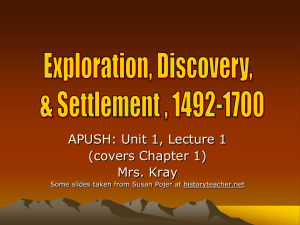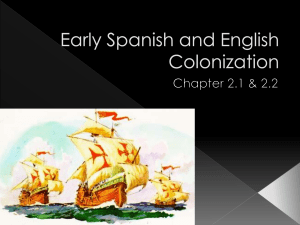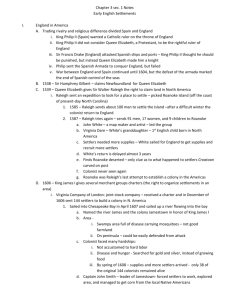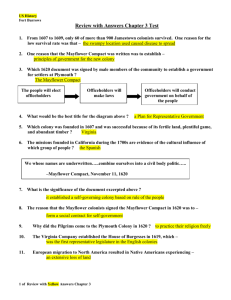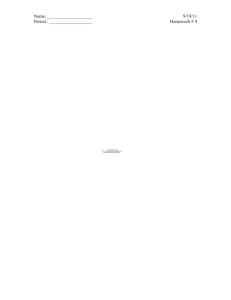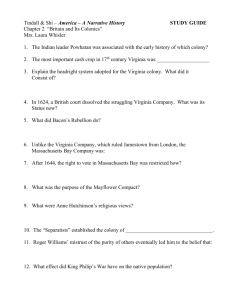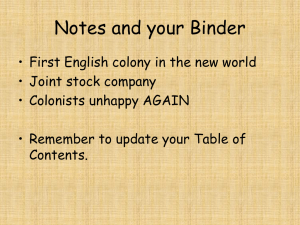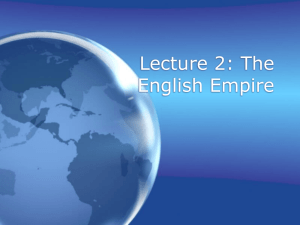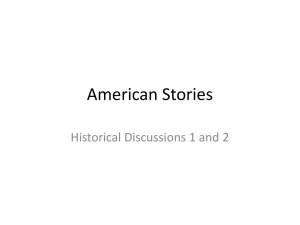Chapter 3 Colonial America for Online
advertisement
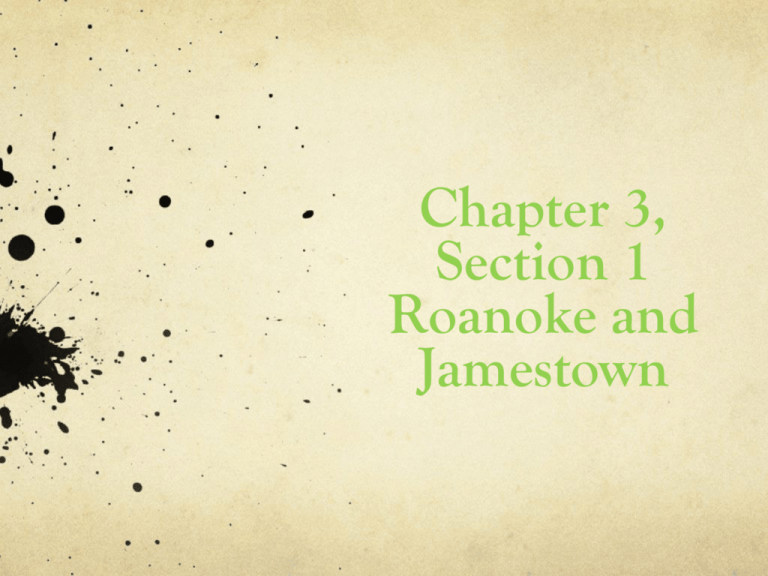
Chapter 3, Section 1 Roanoke and Jamestown 1584, Sir Walter Raleigh was given the right to claim land in North America by Queen Elizabeth. Raleigh found Roanoke Island (in present day North Carolina), he called this area Virginia. The first group of people arrived in 1585, but after a difficult winter, the colonists returned to England. 1587, Raleigh sent another group, led by John White White returned to England for supplies, and hoped to be back within a few months. Because England was at war with the Spanish Armada, White did not return for 3 years. When he returned, he found a deserted colony. The only clue found was the word Croatoan carved on a tree. The Roanoke colonists were never seen again. England did not try settling in North America again until 1606. The Virginia Company planned for settlers to find gold and establish trade in fish and furs in America. It was a joint-stock company – investors bought shares or part ownership, hoping the company would make money. King James I granted a charter (a document that granted the right to form a colony) to the Virginia Company. The company’s settlers entered America through the Chesapeake Bay in April 1607. The colonists faced severe hardships, including disease and hunger, and did not find riches. The colony survived its first 2 years because of Captain John Smith. He built ties with and got food from the local Powhatan people. Forced the settlers to work. Smith returned to England, and the winter of 1609-1610 was called the “starving time”. This is definitely NOT what they looked like. Settlers began to grow a type of tobacco using seeds from the West Indies. Made money for the investors. Relations with Powhatan improved after John Rolfe married Pocahontas. The Virginia Company began giving a headright (land grant of 50 acres to settlers who paid their own way). Land-owning male colonists were allowed to cast ballots for burgesses (or representatives). Burgesses The Virginia colony was growing in size, but was not making any money for its shareholders. In 1624, King James took away the company’s charter and Virginia became a royal colony. It was directly under the control of the government. October 2nd, 2012 Journal 10 How does geography influence the way people live? What ultimately led to the failure of Roanoke and the success of Jamestown? Homelearning Building a Colony project due next class! Complete guided reading worksheet on the website. Chapter 3, Section 2: The New England Colonies Remember me? When King Henry VIII broke away from the Catholic Church and formed the Anglican Church, many people dissented. Puritans- Protestants who wanted to reform the Anglican Church. Separatists- Those who sought to set up their own churches. Were often persecuted and many fled. Pilgrims- Separatists who moved to 1620 America (someone Were allowed to who takes a religious practice their journey). religion freely They received a land grant from the Virginia Company and were headed to Virginia. The Mayflower Because (their ship) landed Plymouth was in Plymouth outside of the (present day Virginia laws, Massachusetts). they decided to They signed the set up their own Mayflower government. Compact, set up an organized, orderly government. Each signer promised to obey the laws passed “for the general good of the colony.” During their first winter in America, almost half the Pilgrims died of Illness, hunger and the cold. Two Natives, Squanto and Samoset, taught the pilgrims to grow crops and helped them make peace with other natives who lived in the area. •Taught the Pilgrim how to grow corn, beans, and pumpkins and showed the colonists where to hunt and fish. •The pilgrims included their new friends in a fest of thanksgiving. The Massachusetts Bay Company received a royal charter and established a colony north of Plymouth, known as Boston. During the 1630s more than 15,000 Puritans journeyed to Massachusetts to escape religious persecution. John Winthrop was chosen to be the colony’s governor. Settlers later demanded a larger role in the government. Adult, male church member, who owned property were allowed to vote. The Puritans had little tolerance for different beliefs, and strictly enforced their own religious rules. Thomas Hooker led a movement to the Connecticut River Valley. Three years later, several towns near this area adopted a plan of government called the Fundamental Orders of Connecticut. Similar to the Mayflower Compact, it reflected a belief in democratic principles. Roger Williams founded Rhode Island. Believed it was wrong for settlers to take land away from Native Americans First place in America where people of all faiths could worship freely John Wheelwright followed Williams’s ideas, and later established New Hampshire 1675, native leaderMetacomet waged war against the New England colonies. King Philip’s war raged for 14 months, and ended with the native’s defeat. Create a series of journal entries about the Pilgrim’s experiences in Plymouth. Journal must be at least three separate entries Must include at least one picture. Must write about one of the following 3 environments: Writing the Mayflower Compact Meeting of Samoset and Squanto Celebrating the 1st Thanksgiving.

